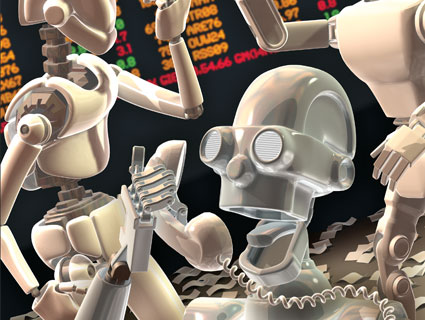
<a href="http://www.shutterstock.com/pic.mhtml?id=59195659">pilgrim.artworks</a>/Shutterstock
On Monday, we posted my story on high-speed trading from the January/February print issue of Mother Jones. (Read it!) Here’s the nut:
As technology has ushered in a brave new world on Wall Street, the nation’s watchdogs remain behind the curve, unable to effectively monitor, much less regulate, today’s markets. As in 2008, when regulators only seemed to realize after the fact the threat posed by the toxic stew of securitization, the financial whiz kids are again one step—or leap—ahead…
…[Knight Capital’s big loss on August 1] wasn’t the worst-case scenario. Not even close. A lot of high-frequency trading is done by small proprietary trading firms, subject to less oversight than brand name financial institutions. But big banks have also tried to get in on the act. Imagine a runaway algorithm at a too-big-to-fail company like Bank of America, which manages trillions, not billions, in assets. Or, says Bill Black, a former federal regulator who helped investigate the S&L crisis of the ’80s and ’90s, imagine trading algorithms causing “a series of cascade failures”—like the domino effect that followed Lehman’s collapse. “If enough of these bad things occur at the same time,” he says, “financial institutions can begin to fail, even very large ones.” It’s not a question of whether this will happen, Black warns. “It is a question of when.”
Years of mistakes and bad decisions led to the 2008 collapse. But when the next crisis happens, it may not develop over months, weeks, or even days. It could take seconds.
One quote I couldn’t fit in the final story illuminates the point that the nation’s watchdogs are behind the curve. When I asked Gregg Berman, the Securities and Exchange Commission expert who headed the agency’s inquiry into the flash crash, how he’d describe the SEC’s role, he responded with an extended metaphor:
Berman compares the agency’s role in the marketplace to how traffic laws are created and enforced. A town can pass rules setting speed limits that take into account traffic flow and safety, and patrol officers can use radar guns to measure the speed of individual cars, issuing tickets when violations occur. But the officer is not actually in the car and cannot step on the brake pedal as soon as the driver begins to violate the speed limit. Similarly, the SEC is not generally an active market participant “steering the car” in real time. Instead, it acts through policies that do act in real time. For example, the single-stock circuit breakers, put in place after the flash crash, are designed to automatically hit the brakes and halt trading under disorderly market conditions, akin to programing the car to hit the brakes automatically when a potential collision is detected.
That the SEC isn’t “in the car,” steering in real time, is obvious to anyone who works in finance—as Berman notes, the agency is limited to accident-avoidance technologies that are programmed in advance. It’s obvious why this is: Giving the SEC the ability to monitor and shut down trading in real time would be enormously expensive and would likely slow down trading considerably. (Imagine if someone sitting in the passenger seat while you drive, with their own wheel and set of brakes. You probably wouldn’t like it.)
To the uninitiated, though, this point might seem pretty scary. The SEC is relying on automatic measures—designed in response to the last disaster—to slam on the brakes if a potential collision is detected. But the “cars” (trading firms) are hurtling down highways faster than ever before, and many of them are being “driven” by robots—sophisticated trading algorithms that buy and sell securities automatically, without human intervention.
One crash, and the demise of one trading firm, isn’t such a big deal. But what about a chain-reaction crash? What about a multi-car pileup?
Here’s the bottom line: If the SEC’s automatic measures fail, it won’t be able to react in time to avert a crisis. It will only be able to come in after the fact and try to clean up the mess. We accept this sort of thing when it comes to cars. But even the largest of car crashes can’t wreak the kind of economic havoc that a series of cascade failures in the market could.













